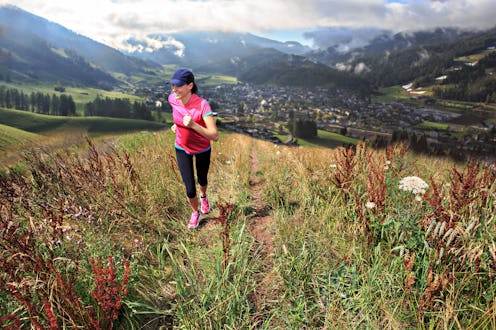Life
How to Make Running Up Hills Less Awful

Running is a super-effective way to get in your cardio and tone up all over, and it's one of the easiest workouts to get started in. Unfortunately, it has a tendency to be a bit monotonous, especially if you are hitting up the same treadmill or trail every time.
To beat the boredom, why not switch things up with hill running? Hill running not only raises the intensity factor by a million, but elevated runs can also tone your entire body more quickly (who's going to say no to that?), increase lung capacity, and boost your endurance. Basically, this can make you a better runner. Score!
Kim Maxwell, a Minneapolis-based running coach and founder of KMax Fitness, offers her tips on how to conquer hills like a boss, whether you're a seasoned marathoner or just lacing up your sneakers for the first time.
Start Off With Some Mileage, if You're New
Hill running has been recommended to distance runners for years, since it helps build grit and trains your body to power through those I'm-going-to-die-if-I-run-any-further moments during your run. But you don't need to be running marathons to reap the benefits; it's a great workout to add in for beginners, too.
The key is not to just hop on any old hill. Maxwell suggests newbies "first build a nice base of easy miles, about two to three, before hitting the hills, and look for a hill that's a relatively low grade."
If you're a running rookie, plan to do one hill workout each week, and then build up to two, taking a day off afterwards to let the body recover. Running veterans can do two longer hill runs each week.
Pay Attention to Form
When you're tackling uphill, it's tempting to lengthen your steps to run up that sucker faster. But Maxwell points out that this strategy can tire you out more quickly.
"To be the most efficient, you'll want to actually take short steps, lifting your knees up high, increasing your arm swing and leaning slightly into the hill."
Change Your Downhill Technique
Running uphill is hard, but it's actually the trek downhill that can be tougher on your body. "Running downhill is all about control," Maxwell says. "You won't need to swing your arms like when you're going uphill. Also, avoid landing on your heels and shoot for touching down on the ball of your foot instead."
If you're cruising down a steep hill, it's also a great idea to zigzag on the way down to lessen impact on the body and joints.
Keep it Loose
No doubt, hill training can kick your butt, so it's easy to tense up, especially during the uphill part. "A big mistake that many runners make is raising the arms and clenching the fists while running. Not only does this add stress to the upper body, it can tighten you all over," Maxwell says.
Her advice is to relax the arms and unclench fists; think of holding a bag of potato chips that you don't want to crush between your fingers.
Images: Val Thoermer/Fotolia; giuseppemilo/Flickr (2); pedrosimoes7/Flickr; chucka_nc/Flickr